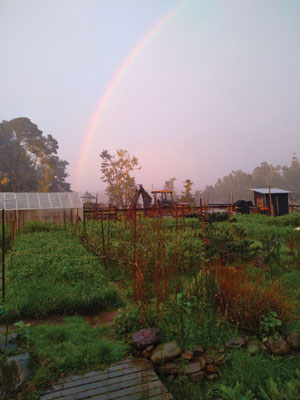Diet Divine
How many different diets can you create? The sky is the limit; but for many people, so is space—and the potential carbon production possible in that space, with which to build annual soil-sustaining compost piles. With the help of Ecology Action's Self-Teaching Mini-Series Booklet #31: Designing a GROW BIOINTENSIVE® Sustainable Mini-Farm, this process is as close to simple and pain-free as it can get. Our modern agribusiness food systems and methods of teaching farming rely on a MORE-BIGGER-FASTER mentality, while the methods and techniques that comprise the GB method rely on a SMALL-ELEGANT-SUSTAINABLE approach. There is a dance to deciphering the requirements for producing all your own calories, income, and soilnourishing compost in as small an area as possible. For a 1,000 sq. ft. garden, this is challenging and requires us to draw on the time-honored traditions and techniques of the GB method. Booklet #31 walks you through this process, stepby- step and day-by-day, to reach the goal of designing a complete diet, using simple forms that you fill out to gain clarity on what it is exactly that you need to do to accomplish this. In my own experience, this kind of process is totally unique in the whole world of agricultural educational materials, to Ecology Action. GB parses the sustainability of our garden/ mini-farm by utilizing certain percentages of crops with specific capacities for carbon and/or calorie production. Recommendations for general sustainability are that you should not devote more than 2.5 to 10% of your mini-farm to low-calorie producing crops (like lettuce, kale, tomatoes), 30% to high-calorie production root crops (like potatoes, leeks, parsnips), and 60% to high-carbon and -calorie producing crops (like quinoa, flour corn, barley). As you follow this 60:30:10 ratio and fill out the forms, you will begin to see how the process unfolds. It may seem daunting at first, but you just have to commit to the process and START NOW! From my experience it is best to not over-analyze or try to strategize for a specific outcome as you first embark on the form calculations, unless you want a headache and some wasted time. Sharpen your pencil and avoid the finality of ink on paper. This is not just a rote exercise with a predetermined outcome: this is truly a process of self discovery and “self uncovery” if I may coin a new term. What do you truly like to eat in your heart of hearts? Does this crop selection fall into your plan with the ratio of 60:30:10 guidelines? What can your climate and farm site best produce with the reality of the weather patterns and soil with each passing year? Do you have enough space or skill to grow this crop? You will certainly find out! I think if you follow the process like so many have before you, will be pleasantly surprised with what you're able to produce each year, towards the journey of learning to nourish and feed yourself, and helping others around you to do the same. Once you have completed the forms, don’t stop there! This process will continue to refine and define itself, and your future self will be grateful you took the time and effort to undergo the challenge of our time. We are all re-imagining our selves with each passing hour, day, and year, and the garden is the perfect place to make the changes happen in your own life. The challenge we all face, and will face more and more, is that the way our current culture treats the great mother Earth has to be shifted towards a caring, loving, and productive stewardship of the life-support systems of the biosphere. With GB practices and methods this becomes like breathing, or drinking water, effortless yet eminently necessary. I want to wish you the best of luck for the year to come and may this spring help you to grow as much as your vegetables will ♥ top | Newsletter Home |Table of Contents| Archive
|


 Hello from the Victory Gardens for Peace in
Mendocino, CA! On the rainy, chilly, and
blustery days before spring comes into
full swing, while we rest inside, what can we do to
further our knowledge and experience in the art
of GROW BIOINTENSIVE (GB) farming/gardening?
How about creating/polishing a 1,000 sq. ft. Diet
Plan? This has been my task as I gain a deeper
familiarity with GB methods.
Hello from the Victory Gardens for Peace in
Mendocino, CA! On the rainy, chilly, and
blustery days before spring comes into
full swing, while we rest inside, what can we do to
further our knowledge and experience in the art
of GROW BIOINTENSIVE (GB) farming/gardening?
How about creating/polishing a 1,000 sq. ft. Diet
Plan? This has been my task as I gain a deeper
familiarity with GB methods.